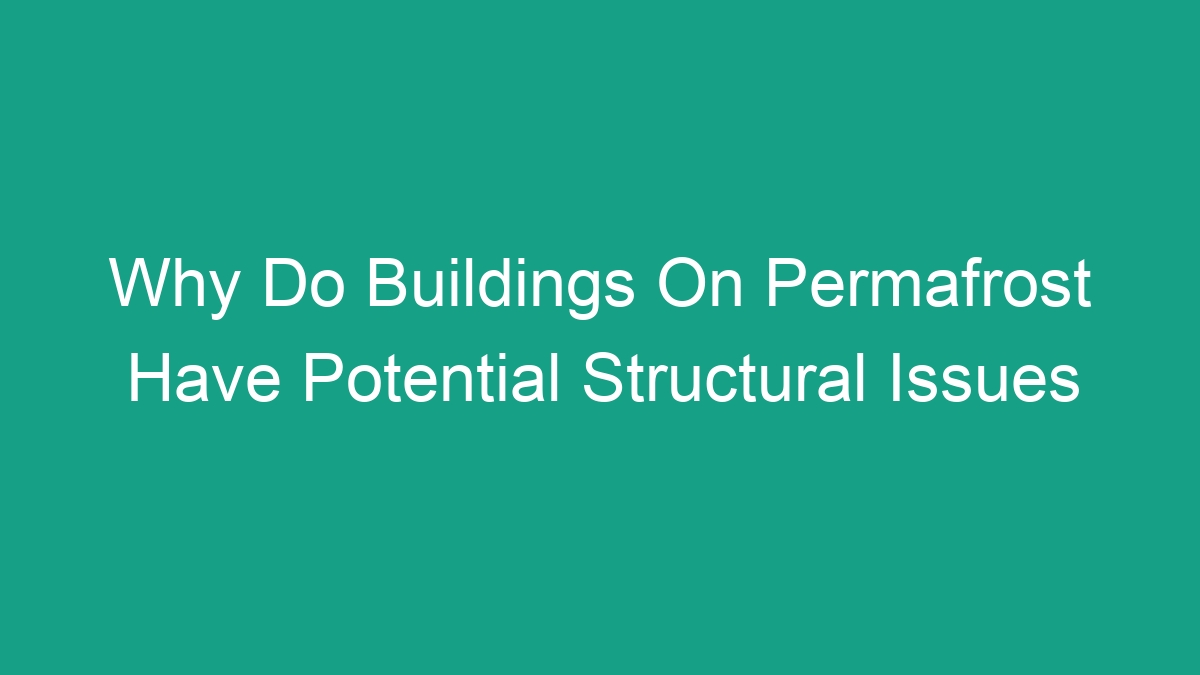
Building on permafrost presents unique challenges and risks due to the unstable nature of the ground. Permafrost is defined as soil, rock, or sediment that remains frozen for at least two consecutive years, and it covers about 24% of the exposed land surface in the Northern Hemisphere.
In this article, we will explore why buildings on permafrost have potential structural issues, the impacts of climate change on permafrost, and some potential solutions to mitigate these risks.
Understanding Permafrost
Permafrost is found in cold regions, including the Arctic, Antarctic, and high mountain ranges. The frozen ground can range in thickness from a few feet to several thousand feet, with an average depth of about 500 meters in the Northern Hemisphere.
Permafrost can be classified as either continuous, discontinuous, or sporadic. Continuous permafrost is found in regions where the ground remains frozen throughout, while discontinuous and sporadic permafrost are found in areas where the permafrost is fragmented or occurs in isolated patches.
One of the key characteristics of permafrost is its susceptibility to thawing. As temperatures rise due to climate change, permafrost becomes increasingly unstable, leading to changes in the landscape and potential damage to infrastructure built on top of it.
Why Do Buildings on Permafrost Have Potential Structural Issues
1. Thaw Settlement
Thaw settlement occurs when the ice-rich permafrost thaws, causing the ground to settle and potentially damage buildings and infrastructure. As the ice within the permafrost melts, the ground can sink or shift, leading to structural issues such as foundation cracking, uneven settling, and damage to utility lines.
2. Differential Settlement
Differential settlement is a common problem associated with building on permafrost. It occurs when different parts of a building’s foundation settle at different rates, leading to uneven stress on the structure. This can result in cracks, uneven floors, and other structural issues that compromise the overall stability of the building.
3. Thermokarst Formation
Thermokarst is a type of landform that forms as a result of the thawing of ice-rich permafrost. It can lead to the formation of depressions, sinkholes, and other irregularities in the terrain, which can pose significant risks to buildings and infrastructure. The collapse of thermokarst features can damage foundations and lead to structural instability.
4. Frost Heave
Frost heave occurs when the freezing and thawing of the ground causes soil and rocks to rise upwards. This process can exert significant pressure on building foundations, leading to structural damage and instability. Frost heave is a common issue in areas with permafrost and can pose significant challenges to building design and construction.
The Impact of Climate Change on Permafrost
The stability of permafrost is being directly impacted by climate change. As global temperatures rise, permafrost is experiencing accelerated thawing, leading to increased risks for buildings and infrastructure built on top of it. The impacts of climate change on permafrost include:
1. Thawing Permafrost
The most significant impact of climate change on permafrost is the increased thawing of previously frozen ground. As temperatures rise, the ice within the permafrost melts, leading to changes in the landscape and potential damage to buildings and infrastructure.
2. Increased Thermokarst Formation
Climate change is also contributing to the increased formation of thermokarst features. As the permafrost thaws, the release of trapped gases and the collapse of ice-rich deposits can lead to the formation of thermokarst landforms, which pose risks to buildings and infrastructure.
3. Infrastructure Damage
The impacts of climate change on permafrost are already being felt in the form of damage to buildings, roads, and other infrastructure. As the ground becomes more unstable, the risks to existing structures and future developments increase, requiring proactive measures to mitigate the potential damage.
Potential Solutions to Mitigate Risks
Given the potential structural issues associated with building on permafrost, it is essential to consider proactive measures to mitigate the risks. Some potential solutions include:
1. Site-specific Design and Construction
Building on permafrost requires careful consideration of site-specific conditions. Engineers and architects need to take into account the unique properties of the frozen ground and design buildings and infrastructure that can withstand the challenges posed by permafrost thawing and settlement.
2. Thermal Protection
One approach to mitigating the impacts of permafrost thaw is the use of thermal protection measures. This can include insulating foundations to minimize heat transfer to the ground, preventing the thawing of permafrost and reducing potential settlement and structural damage.
3. Ground Freezing Techniques
In some cases, ground freezing techniques can be used to stabilize permafrost and prevent thaw settlement. This method involves using artificial means to freeze the ground, creating a stable foundation for buildings and infrastructure in permafrost-affected areas.
4. Monitoring and Maintenance
Regular monitoring and maintenance of buildings and infrastructure on permafrost can help identify issues early and prevent potential damage. This can include inspecting foundations, utility lines, and other critical components to ensure they remain stable and secure.
Conclusion
Building on permafrost presents unique challenges and risks due to the unstable nature of the ground. The increased thawing of permafrost as a result of climate change has the potential to lead to structural issues such as thaw settlement, differential settlement, thermokarst formation, and frost heave.
To mitigate these risks, proactive measures such as site-specific design and construction, thermal protection, ground freezing techniques, and regular monitoring and maintenance are essential. By addressing these challenges, it is possible to build and maintain stable and resilient structures in permafrost-affected areas, ensuring the long-term safety and sustainability of buildings and infrastructure.



